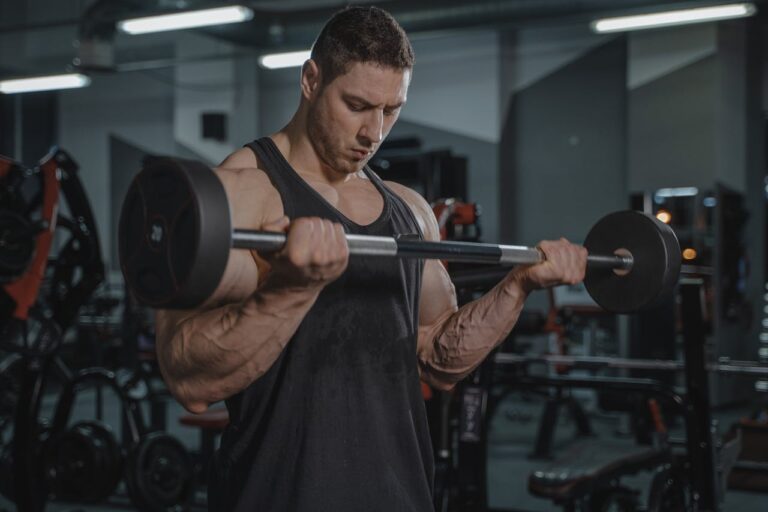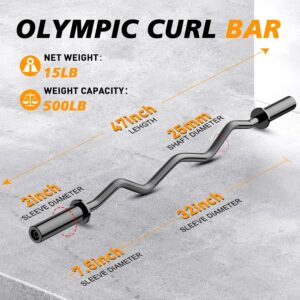When it comes to building impressive biceps, two classic tools stand out in every gym: the straight bar and the EZ curl bar. While both can help you achieve those coveted arm gains, each offers distinct advantages and considerations that could make one a better choice for your specific needs.

Straight Bar: The Classic Approach
The traditional straight bar has been a staple in bodybuilding for generations, and for good reason. When you grip a straight bar, your wrists and forearms maintain a completely supinated (palms-up) position throughout the movement. This creates several important effects:
First, the fully supinated position maximizes biceps engagement. The biceps brachii’s primary functions are elbow flexion and forearm supination, and the straight bar optimizes both. This complete supination particularly engages the long head of the biceps, which can lead to greater overall biceps development.
However, this position comes with some considerations. The fixed straight grip can create significant stress on the wrists and forearms, potentially leading to discomfort or strain for some lifters. Those with existing wrist issues or limited flexibility might find this particularly challenging.
EZ Curl Bar: The Ergonomic Alternative
The EZ curl bar, with its characteristic zigzag pattern, was specifically designed to address some of the limitations of the straight bar. Its varying angles allow for a semi-supinated grip position, which creates several distinct advantages:
The angled grips reduce stress on the wrists and forearms by allowing them to maintain a more natural position during the curl. This can make the exercise more comfortable and potentially safer for those with wrist or forearm issues. The slightly altered grip position also changes the emphasis of the exercise, potentially targeting different aspects of the biceps.
However, this comfort comes with a trade-off. The semi-supinated position may result in slightly less maximum biceps activation compared to a fully supinated grip on a straight bar. This difference is relatively minor for most lifters but could be significant for competitive bodybuilders focused on maximum muscle development.
Making the Right Choice
Your choice between these bars should depend on several factors:
Training Goals: If maximum biceps activation is your primary concern and you have no joint issues, the straight bar might be your best bet. For overall arm development with reduced joint stress, the EZ bar could be more appropriate.
Joint Health: Those with existing wrist, elbow, or forearm issues often find the EZ bar more comfortable and sustainable for long-term training.
Exercise Variety: Many experienced lifters incorporate both bars into their routine, using the straight bar for moderate-weight, strict form sets, and the EZ bar for heavier loads or higher-volume work.
Training Tips for Both Bars
Regardless of which bar you choose, here are some key points to optimize your biceps training:
Maintain proper form throughout the movement. Keep your upper arms stationary against your sides, and focus on moving only at the elbow joint.
Control the negative (lowering) portion of the curl. This eccentric phase is crucial for muscle growth and shouldn’t be rushed.
Experiment with grip width. Both bars allow for different grip positions, which can emphasize different parts of the biceps.
The Bottom Line
Both the straight bar and EZ curl bar are valuable tools for biceps development. Rather than viewing them as competing options, consider them complementary tools in your training arsenal. The straight bar might be optimal for pure biceps activation, while the EZ bar offers improved comfort and sustainability for many lifters.
Consider incorporating both variations into your training program, perhaps using the EZ bar for your heavier sets where joint stress is more significant, and the straight bar for lighter, more controlled work focused on maximum contraction.
Remember, the best choice is ultimately the one that allows you to train consistently and progressively without causing undue joint stress or discomfort. Listen to your body, experiment with both options, and find what works best for your individual needs and goals.
Hey there! We hope you love our fitness programs and the products we recommend. Just so you know, Symku Blog is reader-supported. When you buy through links on our site, we may earn an affiliate commission at no extra cost to you. It helps us keep the lights on. Thanks.
Disclaimer: The information provided in this discussion is for general informational and educational purposes only. It is not intended as medical or professional advice. Only a qualified health professional can determine what practices are suitable for your individual needs and abilities.


